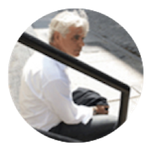About Us
Too little information can be as disconcerting as too much. Patricia Wentworth (inverted)
Augmnt_ed Information
At AUGMNT, we help organizations become aware of the dynamics of the three horizons in which they operate — and more specifically of the permanent relationship they maintain with the future.
Every action unfolds in the present with an intention directed toward what is coming: the call scheduled for this afternoon, the meeting on Friday, the report due in two weeks. The future is always at work within our decisions.
We support organizations to:
- Understand their relationship with the future: by developing Futures Literacy, they learn to use the future as a resource — not as an uncertainty to be managed.
- Connect foresight and continuity strategy: through Horizon Scanning, we help organizations detect signals of change and emerging dynamics. Using our Three Horizons in One System (3H1S) model, we transform these signals into a coherent understanding of Growth and Continuity — that is, the organization’s ability to protect its current assets (H1), adapt to the tensions of change (H2), and transform in alignment with the future it aims to create (H3).
- Better manage strategic risks: not only to protect themselves, but also to liberate the opportunities often hidden within those same risks, across all horizons.
- Prepare for an agentic and autonomous future: by developing a cognitive architecture capable of interacting with environments increasingly augmented by AI.
This comprehensive understanding of Growth and Continuity across the three horizons forms what we call an organization’s cognitive architecture — the foundation upon which its strategy, resilience, and capacity to evolve coherently in a transforming world depend.
About The Founder
 Christian Royer is the instigator of AUGMNT — a synthesis of four decades spent navigating law, finance, and strategic systems.
Christian Royer is the instigator of AUGMNT — a synthesis of four decades spent navigating law, finance, and strategic systems.
He first encountered the Three Horizons framework in 2004, recognizing it not as a planning tool but as a dynamic way of perceiving continuity, tension, and transformation. At the time, while working with investors, he observed that those who consistently outperformed weren’t reacting faster — they were thinking in horizons, intuitively balancing present performance with emerging opportunity.
This realization reshaped his work: long-term continuity does not depend on the ability to predict outcomes, but on the capacity to relate intelligently to change — to interpret signals, translate them into structure, and act coherently across time. Over time, he evolved this insight into a complete cognitive architecture, integrating the structural logic of Futures Thinking, the learning orientation of Futures Literacy, and the systemic coherence of design and control disciplines (TQM, System Dynamics, VSM).
His current work examines how strategic risk emerges from the way organizations perceive, interpret, and act across horizons — treating information not as data to be managed, but as a living architecture that shapes coherence, learning, and adaptation.
